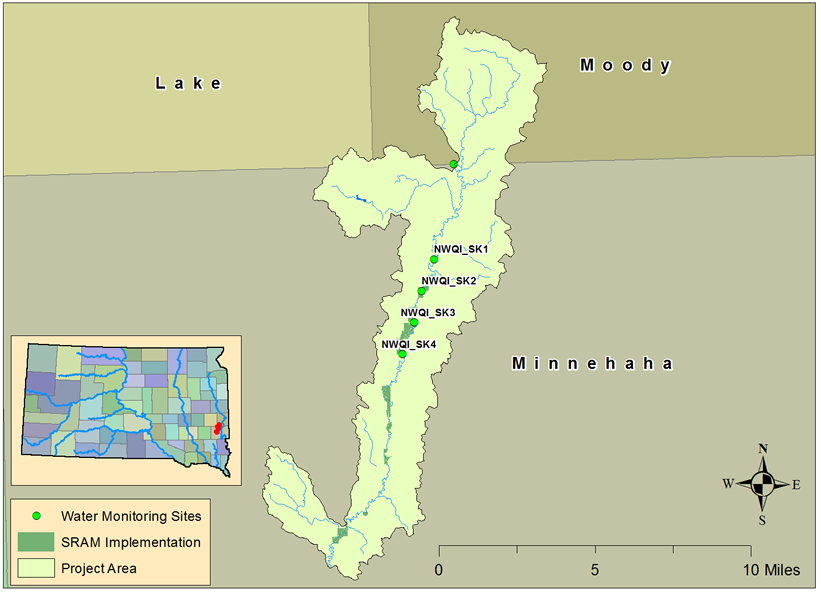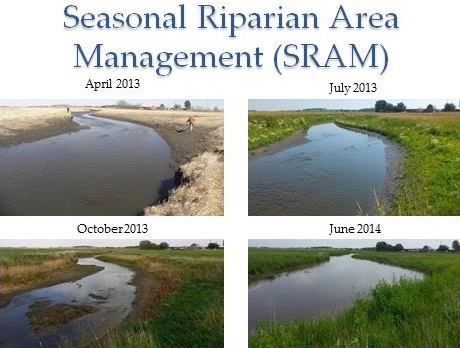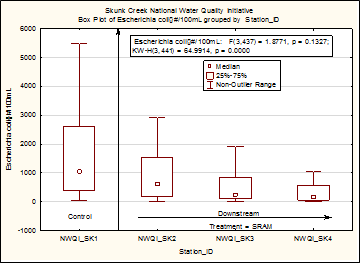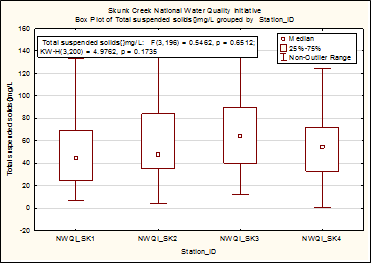Watershed Protection
IN SOUTH DAKOTA
Skunk Creek NWQI Project
The National Water Quality Initiative
The National Water Quality Initiative (NWQI) targets small, high priority impaired watersheds for water quality improvement projects. Funding from the Natural Resources Conservation Service (NRCS), the South Dakota Department of Agriculture and Natural Resources (DANR) and the City of Sioux Falls was used to accelerate existing implementation efforts in the Jensen Creek-Skunk Creek watershed. NRCS works closely with conservation partners to select priority watersheds where on-farm conservation investments will deliver the greatest water quality improvements. The goal of an NWQI project is to implement conservation practices in sufficient quantity in a concentrated area so that agriculture no longer contributes to the impairment of water bodies within the watershed.
Skunk Creek Watershed
The Skunk Creek watershed is located in eastern South Dakota in the Big Sioux River basin. Skunk Creek is included on the 303(d) list of impaired waters in the 2014 South Dakota Integrated Report for Surface Water Quality Assessment for E. coli and Total Suspended Solids (TSS) impairment and is a significant source of E. coli bacteria to the Big Sioux River. The primary source of the bacteria in the watershed is believed to be domestic livestock, although human, pet and wildlife sources have been found to contribute a portion of the total load.
The purposes of this water quality monitoring project are to:
- Establish baseline concentration and loading levels for bacteria, sediment, and nutrients within the Jensen Creek-Skunk Creek watershed at both upstream control and downstream treatment sites prior to installation of BMPs.
- Monitor established sampling sites for changes in pollutant concentration levels, BMP tracking, stream habitat measurements, weather and streamflow throughout the implementation phase.
- Complete statistical analysis on the data to determine if the effect of BMPs on the sources of nonpoint pollution is significant using multiple lines of evidence.
 Skunk Creek watershed map including BMP and sampling locations.
Skunk Creek watershed map including BMP and sampling locations.
 Time lapse of Seasonal Riparian Area Management on Skunk Creek.
Time lapse of Seasonal Riparian Area Management on Skunk Creek.
New Best Management Practices (BMPs) Developed
A new BMP termed Seasonal Riparian Area Management (SRAM) was designed to encourage more landowners and operators within the Skunk Creek watershed to install BMPs. Enrollment of land immediately adjacent to Skunk Creek and within the 100 year flood plain is eligible for the program. Livestock producers enrolling pasture into the program are paid $60 per acre to defer grazing during the recreation season (April through September) but would be allowed to graze from October through March as long as a minimum vegetative stand of 4 to 6 inches remained. An alternative water source was required if the grazing was to take place during the dormant grazing period to minimize impacts on the riparian area (cost shared up to 75%). Haying is allowed from June through September to utilize the forage and maintain the vigor of the vegetative stand. SRAM has turned into a very popular BMP and has been expanded to the rest of the Central Big Sioux Watershed with emphasis still on the major tributaries in the Skunk Creek basin.
Results
Significant reductions in E. coli concentrations were observed between the control and treatment sites. This means less bacteria from livestock and other sources are reaching the creek. However, no reductions were shown for nutrient and sediment parameters. It may take more time to see improvements in these parameters because stream banks and channels can take some time to fully stabilize. A slight improvement was exhibited in Index of Biotic Integrity scores for fish and aquatic macroinvertebrates in the presence of SRAM, indicating that a modest improvement in ecological health has been observed since SRAM was implemented.

 Graphs of E. coli and Total Suspended Solids (TSS) grouped by sampling site for Skunk Creek.
Graphs of E. coli and Total Suspended Solids (TSS) grouped by sampling site for Skunk Creek.
Additional Questions
- Will a long term change be exhibited by the biological community?
- Is some of the bacteria stored in the bed of the sediment and rereleased during storm events?
- Will additional exposure to the suite of BMPs including SRAM provide reductions in total suspended solids and nutrients over time?
Partnering Agencies